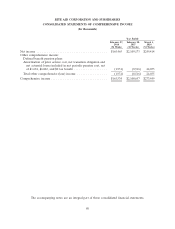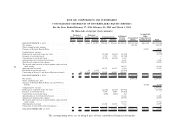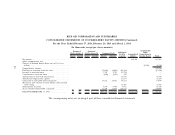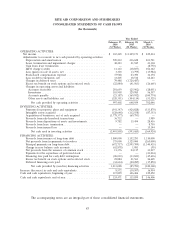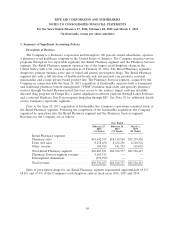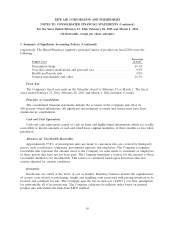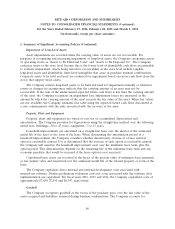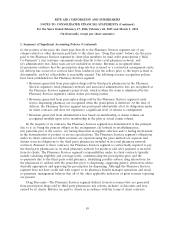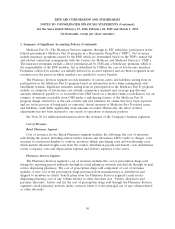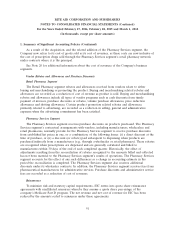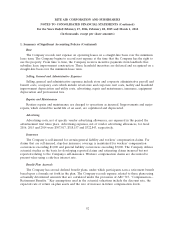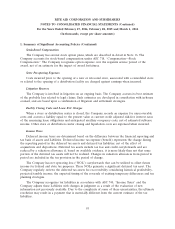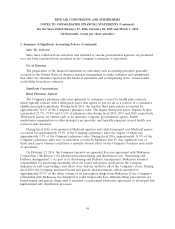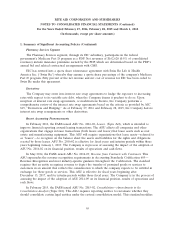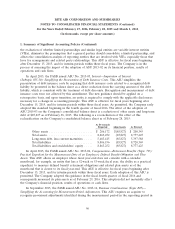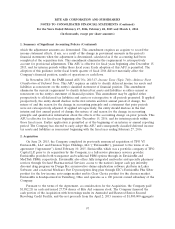Rite Aid 2016 Annual Report Download - page 87
Download and view the complete annual report
Please find page 87 of the 2016 Rite Aid annual report below. You can navigate through the pages in the report by either clicking on the pages listed below, or by using the keyword search tool below to find specific information within the annual report.RITE AID CORPORATION AND SUBSIDIARIES
NOTES TO CONSOLIDATED FINANCIAL STATEMENTS (Continued)
For the Years Ended February 27, 2016, February 28, 2015 and March 1, 2014
(In thousands, except per share amounts)
1. Summary of Significant Accounting Policies (Continued)
goodwill under ASC Topic 350, ‘‘Intangibles—Goodwill and Other’’, which does not permit
amortization, but instead requires the Company to perform an annual impairment review, or more
frequently if events or circumstances indicate that impairment may be more likely. See Note 12 for
additional information on goodwill.
Intangible Assets
The Company has certain finite-lived intangible assets that are amortized over their useful lives.
The value of favorable and unfavorable leases on stores acquired in business combinations are
amortized over the terms of the leases on a straight-line basis. Prescription files acquired in business
combinations are amortized over an estimated useful life of ten years on an accelerated basis, which
approximates the anticipated prescription file retention and related cash flows. Purchased prescription
files acquired in other than business combinations are amortized over their estimated useful lives of
five years on a straight-line basis. The value of finite-lived trade names are amortized over 10 years on
a straight-line basis. The value of customer relationships, acquired in connection with the Company’s
acquisition of EnvisionRx, are amortized over a period between 10 and 20 years on a descending
percentage method which matches the pattern of expected discounted cash flows. The Pharmacy
Services segment’s contract with CMS for Medicare Part D, which is required in order to act as a
national provider of the Part D benefit, is amortized over 25 years on a straight line basis.
Deferred Financing Costs
Costs incurred to issue debt are deferred and amortized as a component of interest expense over
the terms of the related debt agreements. Amortization expense of deferred financing costs was
$19,545, $15,301 and $15,259 for fiscal 2016, 2015 and 2014, respectively.
Revenue Recognition
Retail Pharmacy Segment
For front end sales, the Retail Pharmacy segment recognizes revenue from the sale of merchandise
at the time the merchandise is sold. The Retail Pharmacy segment records revenue net of an allowance
for estimated future returns. Return activity is immaterial to revenues and results of operations in all
periods presented. For third party payor pharmacy sales, revenue is recognized at the time the
prescription is filled, which is or approximates when the customer picks up the prescription and is
recorded net of an allowance for prescriptions that were filled but will not be picked up by the
customer. For all periods presented, there is no material difference between the revenue recognized at
the time the prescription is filled and that which would be recognized when the customer picks up the
prescription. For cash prescriptions and patient third party payor co-payments, the Retail Pharmacy
segment recognizes revenue when the patient picks up the prescription and tenders the cash price or
patient third party payor co-payment amount at the point of sale. Prescriptions are generally not
returnable.
The Retail Pharmacy segment offers a chain wide loyalty card program titled wellness +. Members
participating in the wellness + loyalty card program earn points on a calendar year basis for eligible
87





